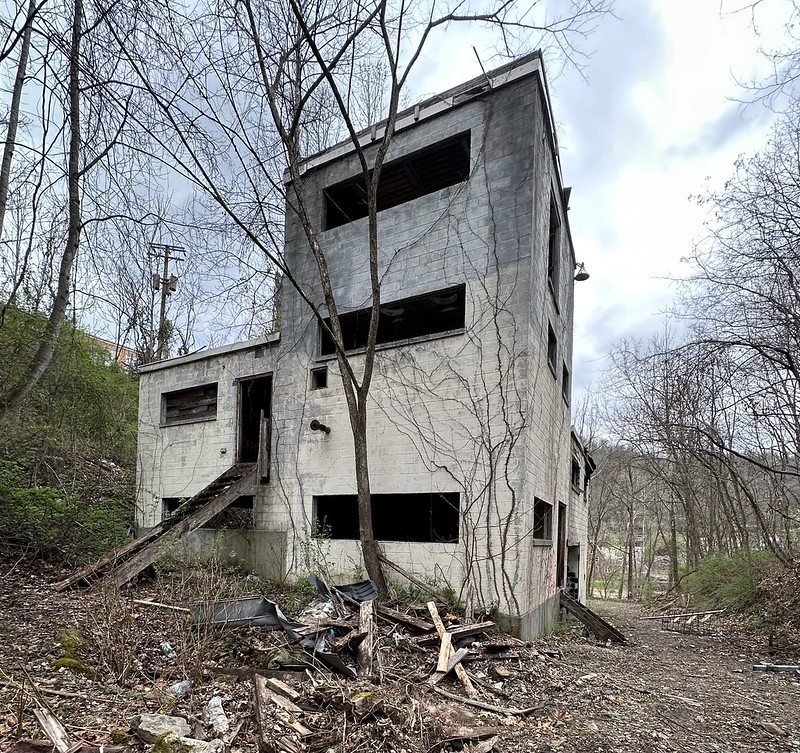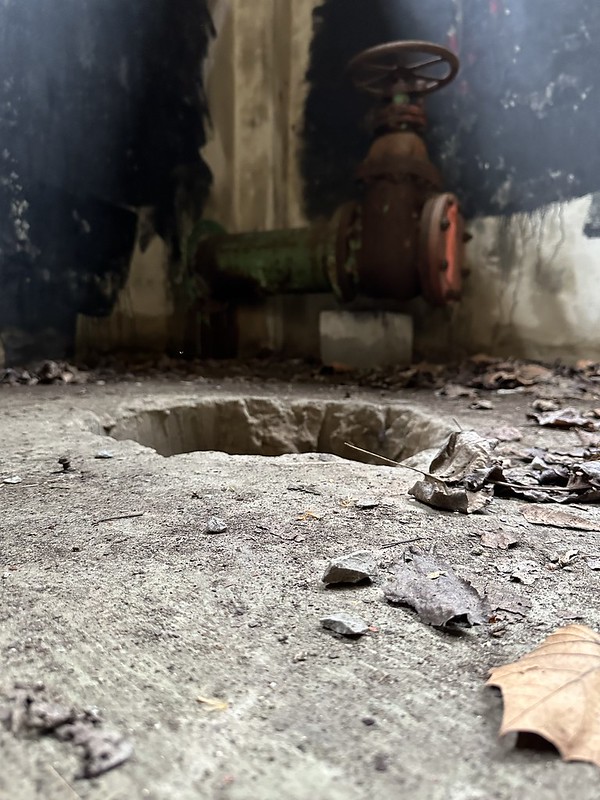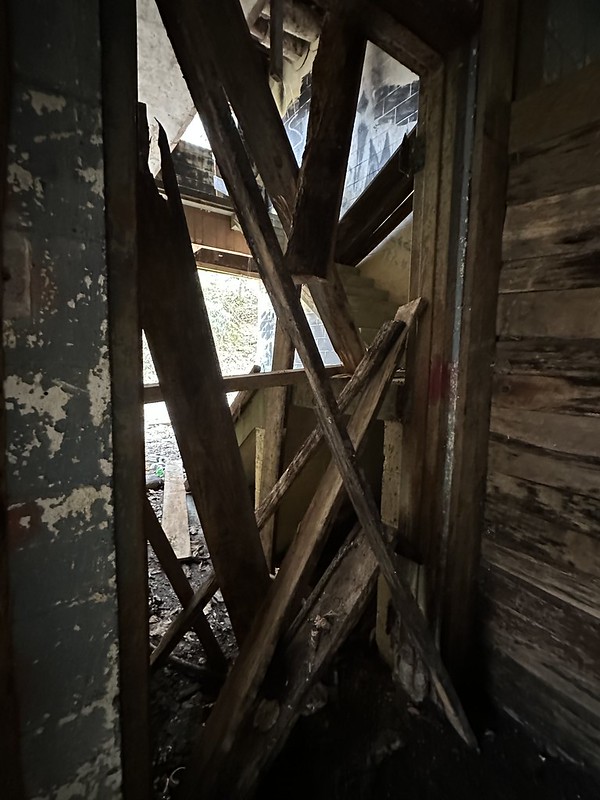Abandoned Appalachia Series

A Mid‑Century Push for Modern Utilities
In the years after World War II, small cities across the southern Appalachian coalfields raced to install the public works that bigger towns already took for granted. Whitesburg’s answer was a stout, cinder‑block water‑treatment plant erected at the foot of School Hill, just yards from Main Street and the North Fork of the Kentucky River. Precise construction records have eluded local historians, but city ledgers and newspaper ads indicate the plant was fully operational by the early 1960s—part of the city’s mid‑century investment in paved streets, new schools, and modern utilities.
The design was strictly utilitarian: two stories of concrete bays, raw block walls, and steel‑framed windows that opened onto settling basins below. Yet for more than forty years those pumps and filters supplied Whitesburg’s homes, schools, and The Mountain Eagle pressroom with safe drinking water pulled straight from the river that winds through downtown.
Decline and Replacement
Regulations tightened, demand grew, and by the late 1990s the little plant could no longer keep pace. Engineers warned city officials that both capacity and contamination standards would soon be out of compliance. In 2003 Whitesburg secured state‑backed loans for a new, larger treatment facility on a more spacious riverside lot. The project slogged through contractor defaults and the surprise discovery of unstable riverbank soils before finally coming online in 2006.
With the flip of a switch the original School Hill plant—already half a century old—was decommissioned, drained, and abandoned. Ownership reverted to the City of Whitesburg; the building itself, however, was simply locked and left to its own devices.

Rebirth as “Brimstone”: A Volunteer Haunted House (2006 – 2016)
Few structures lend themselves to a good scare like an empty industrial cube. Seizing the opportunity, local resident Sabrina Flick persuaded City Hall to let volunteers transform the derelict plant into a seasonal haunted attraction. “Brimstone” opened in October 2006 and quickly became a must‑do event in Letcher County. Admission was kept low—often under $10—and 100 percent of the profits went to charity, supporting everything from children’s medical bills to Shriners Hospitals.
Volunteer actors hid in dark filter bays while visitors inched past pipes, catwalks, and the ghostly husks of sand filters. Each room was an improvised set piece: one year a mad‑scientist lab, the next a claustrophobic clown corridor. By the mid‑2010s Brimstone was drawing hundreds of guests over two October weekends, cementing its status as “Whitesburg’s favorite haunted house.”
Vandalism and the Final Season
Popularity, alas, bred problems. During the 2016 build‑out vandals struck four separate times, dousing walls in profanities and smashing props just days before opening night. City police installed cameras and Mayor James Craft promised jail time for trespassers, but the harassment culminated on October 22, 2016 when outsiders hurled rocks through boarded windows while visitors were still inside. Miraculously no one was hurt.
That finale proved to be the end. Organizers had already hinted that 2016 would be Brimstone’s swan song; the attacks sealed the decision. The two‑night run still raised roughly $1,700 for Shriners Hospital for Children, but when the lights went out on Halloween weekend, they went out for good.

Folklore, Graffiti, and Ghost Hunts
The locked‑up plant soon slipped back into silence—but locals swear it never quite lost its voice. Teenagers report muffled screams and clanging pipes after midnight; paranormal websites list it among Kentucky’s most haunted places. City crews board windows and post No Trespassing signs, yet graffiti layers grow thicker by the year.
Inside, detritus from both past lives remains: rust‑red pipes tagged with neon spray‑paint, residual filter sand crunching underfoot, and the occasional latex mask left from Brimstone’s heyday. No formal plans exist to renovate or raze the structure, leaving the building in a peculiar civic limbo—too expensive to repurpose, too beloved (and notorious) to demolish.
Why It Matters
The story of the Old Whitesburg Water Treatment Plant traces a familiar Appalachian arc—post‑war modernization, economic contraction, and inventive community reuse. For half a century the facility served as a municipal lifeline, delivering clean water to an isolated mountain town. When stricter regulations and rising demand rendered the plant obsolete, it shifted from asset to liability, a decaying concrete shell too costly to rehabilitate. Yet in its third act a corps of volunteers transformed that liability into an annual haunted house whose ticket sales funneled thousands of dollars to children’s charities while breathing new folklore into downtown Whitesburg.
Today the boarded‑up structure remains poised between adaptive ruin and adaptive reuse. Whether the next chapter is preservation, redevelopment, or continued myth‑making, the plant’s evolving identity reminds us that Appalachian communities have long repurposed what the industrial economy leaves behind—and that even an abandoned waterworks can become a vessel for collective memory, generosity, and local pride.
Sources & Further Reading
Kassidy Stricklett, “Vandalism jeopardizes popular haunted house,” WYMT, Oct. 12 2016.
“Haunted house vandalized for the fourth time,” WKYT, Oct. 23 2016.
The Mountain Eagle, “Now’s your chance to meet the ghosts of Letcher County,” Oct. 19 2016.
Richard Cheeks, Constructing the New Whitesburg Water Treatment Plant (personal blog).
GhostQuest.net, “Whitesburg Water Treatment Plant – ‘The Old Water Treatment Plant’.”
(If you explore the area, remember that the old Whitesburg Water Treatment Plant is private property—always obtain proper permissions before venturing inside any abandoned structure.)
Author’s Note: This piece is part of the Abandoned Appalachia series, an ongoing exploration of once-thriving communities across the region — places where generations found work, camaraderie, and identity, only to see it all fade as energy markets plummeted, times shifted, and mines went dark. Follow along for more stories of resilience, reinvention, and the powerful lessons these hills still hold.